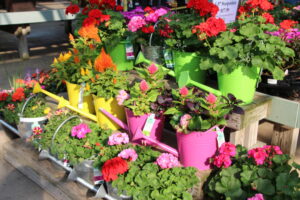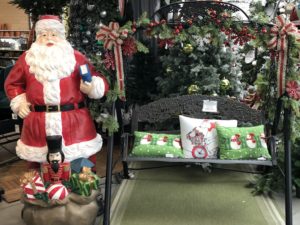Clean Up Your Merchandising
Many garden centers have a rolled-up shirtsleeves look about them. Carts piled with plants in various stages of transit, garden tools scattered here and there, a bit of dirt on the floor. Who’s to care? After all, the customers spend time in their gardens and know it’s a messy business. And a garden center is not supposed to be an upscale gift shop, is it?
Today’s consumers are increasingly sophisticated. They want a variety of product, an efficient store design and yes, they want a neat, professional garden center that is a pleasure to shop.
Not A Destination Spot
There is a lot of talk these days about garden centers becoming destination spots, about creating a dream space where gardeners want to stay for hours just browsing. But what if this isn’t your market? What if a survey of your customers reveals that 95 percent of them come to your store with specific projects in mind, that they want to get what they need and leave and that the best thing you can do to keep them happy is make it easy for them to do so?
Ok, so becoming a destination spot is not for everyone. But even if you don’t have a coffee bar, you can still follow one of the most important merchandising principles followed religiously by the big boys: merchandising maintenance.
Woodinville, Wash.-based Molbak’s has become an industry leader because of their product selection, shopping amenities and service but mostly because of the visual impact of their stores. To the customer, Molbak’s is not a work-in-progress, but the end result — the enticing colors and striking design of lush flowers in bloom with, yes, even the song of birds.
As one visitor to Molbak’s remarked, “everywhere you look, there is a perfect display.” The less obvious, but no less essential component to every perfect display is that it is kept as spotlessly clean as would be a comparable display in an upscale gift shop, which, in fact, is how Molback’s regards itself.
“It has become more and more important for us to differentiate ourselves from the competition,” said Steve Leigh, Molbak’s executive vice president, “Visual merchandising is very important to the customer experience, and it’s a driving force that affects sales. We strive to evoke emotions within the customers, so that everything they see is colorful and exciting, and we keep changing the displays so they keep coming back.”
A Maintenance Case Study
Molbak’s was founded in 1956 by Egon and Laina Molbak, in Woodinville, 20 miles northeast of Seattle. It began as a flower farm, but following the gardening trend of the mid-1990s, galvanized by the arrival of consumer magazines such as Garden Design, Molbak’s expanded into retailing, offering plants from its own greenhouses as well as a Á variety of hardgoods from the furniture and gift categories.
By making the store into a comfortable, entertaining and aesthetically-pleasing environment, Molbak’s automatically differentiates itself from the utilitarian look of the big box stores, and sends the subliminal message that everything that looks good in the store will also look good at home. But, more than that, Leigh explained, store personnel understand that home owners want to be individuals and make their homes unique.
Molbak’s, which does $22 million a year in sales, has a 3,000-sq. ft. garden center at the Pike Street Market in Seattle, and its main store, in Woodinville, has more than 150,000 sq. ft. of covered area situated on a 15 acre site.
Maintaining a space this large, and doing it at the Molbak’s level, takes a dedicated staff that 1) understands their part in the “big picture”, 2) believes in the mission of the “big picture” and 3) strives for perfection.
Each department at Molbak’s has its own staff, with a separate grounds staff to maintain the outside landscaping, and each reinforces constant maintenance. The mundane tasks of watering, pruning dead leaves, wiping, cleaning and sweeping are done constantly. “Everybody has the same awareness of the store,” said Leigh, “so when anything is slightly out of place, it’s taken care of right away.” Continually changing and varying the displays is one thing, Leigh added, but what gives Molbak’s an added dimension is that whenever a customer enters the store, it looks as though it has just been prepared.
As if to emphasize the importance of maintenance, Margo Lagen, Molbak’s visual merchandising manager, has a staff of four full-time merchandisers who spend their days maintaining the displays at Molbak’s. From cleaning to watering to dusting, these employees preserve the store’s perfect look. Lagen said that in addition to this dedicated crew, she spends a full 50 percent of her time on maintenance, while about 40 percent of her time is spent conferring with the store manager, buyers and others about designing specific themes for each product category and actually conceptualizing and implementing the fruit of those brainstorming sessions.
The remaining 10 percent of Largen’s time is now being spent on an in-store education program that teaches basic horticulture, design and maintenance concepts to employees. This is a formal, two-hour course that Largen teaches once each month. It was designed to enhance the hands-on skills employees normally learn going about their jobs and to inspire them to greater efforts. The idea behind the course was not just to teach the employees the skills they would need, but more importantly, to create employees that understand the Molbak’s concept, employees that feel like they are part of the big picture. Largen is currently developing a more advanced course. “The whole staff loves to be creative,” she said, adding that this course gives employees the tools and the confidence they need to act on that creativity. Á
Largen is in charge of the courtyard, which goes through a number of promotional changes every year. Each display change involves a process of cleaning out an area as large as 5,000 sq. ft. and putting in new fixtures, lighting and other infrastructure. Lagen works with store manager Bob Meason, who she reports comes up “with great design ideas,” to create striking visual effects. For instance, at the Christmas show, a flat wall was built with a window in it through which people could gaze, giving a special effect to the merchandise.
Yet, as important as innovative designs are, Largen constantly comes back to the maintenance. The center court is given a thorough cleaning before and after every weekend. “Every time we do a display, we clean the area, check it to make sure it is safe and approachable, and then we clean it again. That way we know it has been thoroughly cleaned before we even start getting creative,” Largen explained.
Home Maintenance
How do these lessons translate to widespread usage? With no direct profit return, can you justify allocating even one full-time maintenance person?
For most operations, the answer to this last question is no. Even at minimum wage, an extra employee is an expense that most nurseries can’t justify, at least not until the busy season or until the economy picks up. But that doesn’t mean your customers have to face yellowing leaves and empty shelves. There are numerous methods for achieving the Molbak’s look — with limited investment.
The first place to start is with current employees. Molbak’s employee education programs can be used as a model. By investing a couple of hours each month training employees in the fine art of merchandising, you can create an entire workforce that understands the importance of and feels they are a necessary part of the design of the store. Followed up with maintenance guidelines, this new sense of pride will result in perfectly maintained displays and a more dedicated work force.
You should also be aware of the opportunities for free labor, otherwise known as interns. Those locations within driving distance of a college have a unique opportunity to obtain the help they need while advancing the floriculture industry. Students in both horticulture and merchandising are anxious for opportunities to test their skills and their career choice. Many of these intern positions are unpaid and offer excited, hard-working employees. Internships can be arranged through either the appropriate department or the university’s career center.
It may also be that you have to time your maintenance efforts. Instead of having people on the floor cleaning and restocking every day, follow Molbak’s lead and thoroughly clean before any new display is arranged and before and after every weekend. Regardless of how you apply it, the often overlooked lesson of Molbak’s consistently perfect look is many hours of maintenance.


















 Videos
Videos





